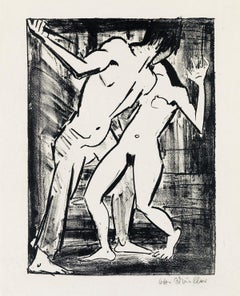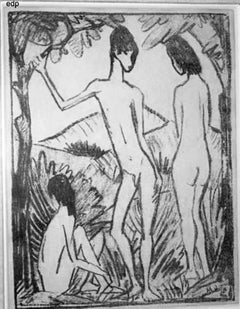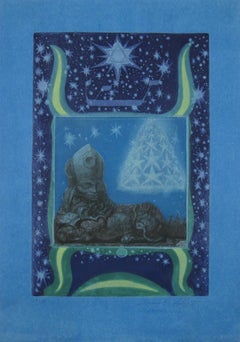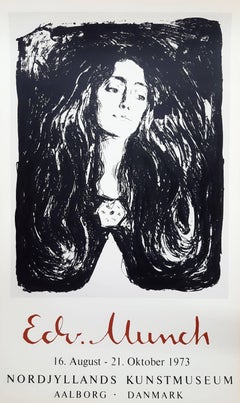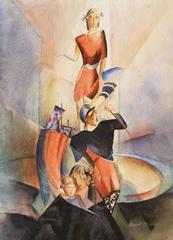Otto Mueller Art
to
3
1
1
4
1
2
1
Overall Height
to
Overall Width
to
3
3
2
2
1
1
1
1
1
1
1
1
4
2
2
4
6,996
3,377
2,513
1,212
3
1
Artist: Otto Mueller
Der Mord II (Liebespaar II)
By Otto Mueller
Located in New York, NY
A superb, richly-inked impression of this very scarce, important German Expressionist lithograph on smooth, cream wove paper. Edition of approximately only 20. Signed in pencil. Publ...
Category
1910s Expressionist Otto Mueller Art
Materials
Lithograph
STEHENDE KNABE UND ZWEI MADCHEN
By Otto Mueller
Located in Portland, ME
Mueller, Otto. STEHENDE KNABE UND ZWEI MADCHEN. Karsch 67. Lithograph, 1917. 12 3/4 x 9 7/8 inches; 323 x 250 mm. Monogrammed in the stone. Edition of about 300. In excellent conditi...
Category
1910s Otto Mueller Art
Materials
Lithograph
LARGE RARE OTTO MUELLER WOODCUT POSTER
By Otto Mueller
Located in Santa Monica, CA
OTTO MUELLER (German 1874 – 1930)
POTSDAMER KUNSTSOMMER, 1921 (1968) (Karsch 6)
Woodcut. Edition of 25 and numbered 11. There are no known
impressio...
Category
1920s Expressionist Otto Mueller Art
Materials
Woodcut
Two Girls - Half Nudes
By Otto Mueller
Located in London, GB
OTTO MUELLER 1874-1930
Liebau 1874-1930 Wrocław, Poland (German)
Title: Two Girls - Half Nudes Zwei Mädchen - Halbakte, 1920
Technique: Original H...
Category
1920s Expressionist Otto Mueller Art
Materials
Lithograph
Related Items
Ernst Fuchs Sphinx Mystagoga Surreal Color Etching Vienna Fantastic Realism 1967
By Ernst Fuchs
Located in Meinisberg, CH
Ernst Fuchs
(Austrian, 1930 - 2015)
The Sphinx Mystagogo
Sheet Nr. 6 from the Folio “Die Sieben Bilder und Sprüche der Sphinx”, published in Autumn of 1967 by Galerie Sydow in Frankfurt, Germany.
• Aquatint Etching
• Ed. 79/99
• Sheet ca. 59 x 41.5 cm
• Plate signed
• Signed & numbered by the artist in pencil
Worldwide shipping for this object is complimentary - There are no additional charges for handling & delivery.
Ernst Fuchs was an Austrian painter, draftsman, printmaker, sculptor, architect, stage designer, composer, poet, and one of the founders of the Vienna School of Fantastic Realism.
I discovered him through H.R. Giger ‘s work, who himself was greatly inspired by the creations of Fuchs and on several occasions exhibited his friend ‘s art in his museum, the Château St-Germain, Gruyères, Switzerland.
I actually own the original folio box...
Category
1960s Surrealist Otto Mueller Art
Materials
Paper, Ink, Aquatint, Etching
Free Shipping
H 23.23 in W 16.34 in
Nordjyllands Kunstmuseum (The Brooch. Eva Mudocci) Poster /// Edvard Munch Litho
By Edvard Munch
Located in Saint Augustine, FL
Artist: (after) Edvard Munch (Norwegian, 1863-1944)
Title: "Nordjyllands Kunstmuseum (The Brooch. Eva Mudocci)"
Year: 1973
Medium: Original Lithograph, Exhibition Poster on heavy wove paper
Limited edition: Unknown
Printer: Unknown
Publisher: Nordjyllands Kunstmuseum, Aalborg, Denmark
Sheet size: 35" x 21.5"
Image size: 24.75" x 19"
Condition: Some minor handling creases. Light toning at edges. In otherwise excellent condition
Rare
Notes:
Printed in four colors: black, black, tan, and red-orange. Produced for a special posthumous exhibition of Munch's work at the Nordjyllands Kunstmuseum, Aalborg, Denmark from August 16 - October 21, 1973. The image featured on this poster is Munch's 1903 lithograph edition "The Brooch. Eva Mudocci", (Woll No. 244, page 208-209).
Edvard Munch would build a strong relationship with Eva Mudocci which lasted many years. They were connected through both romance and also friendship, with the two alternating in importance over time. There was a great mutual respect for each other, with Mudocci being a highly talented violinist from the UK who would regularly tour throughout Europe. They first got together in Paris...
Category
1970s Expressionist Otto Mueller Art
Materials
Lithograph
Sophie aux bas rouges, 1993, original lithograph by Jean Jansem
By Jean Jansem
Located in Carouge GE, GE
Jean Jansem (1920-2013)
Sophie aux bas rouges, 1993
Lithographie sur papier Arches, justifiée E/A
Signée en bas à droite
66 x 50 cm / 76 x 56 cm
Bibliographie:
CR Jansem, 2000, n°...
Category
Late 20th Century Expressionist Otto Mueller Art
Materials
Lithograph
Free Shipping
H 29.93 in W 22.05 in
German Surrealist Hans Bellmer Etching Engraving Print Cecile Reims Surrealism
By Hans Bellmer
Located in Surfside, FL
After Hans Bellmer (German, 1902-1975)
Surrealist engraving, etching
after drawings from a 1942 notebook,
engraved in 1974-75 by Cecile Reims
Printed by L'Atelier de Chalcographie du Louvre, Paris,
Having printed monogram lower left in plate, pencil notations and #7/10 and 'Musee du Louvre' blindstamp verso
Dimensions: Sheet 11 X 7.5, Plate size 6.5 X 4
Hans Bellmer ( 1902 – 1975) was a Polish born German artist, best known for his drawings, etchings that illustrates the 1940 edition of Histoire de l’œil, and the life-sized female sculpture mannequin dolls he produced in the mid-1930s. Historians of art and photography also consider him a Surrealist photographer.
Bellmer was born in the city of Kattowitz, then part of the German Empire (now Katowice, Poland). Up until 1926, he worked as a draftsman for his own advertising company.
Bellmer is most famous for the creation of a series of dolls as well as photographs of them. He was influenced in his choice of art form in part by reading the published letters of Oskar Kokoschka (Der Fetisch, 1925) and Surrealism. Bellmer's puppet doll project is also said to have been catalysed by a series of events in his personal life.
Hans Bellmer takes credit for provoking a physical crisis in his father and brings his own artistic creativity into association with childhood insubordination and resentment toward a severe and humorless paternal authority. Perhaps this is one reason for the nearly universal, unquestioning acceptance in the literature of Bellmer's promotion of his art as a struggle against his father, the police, and ultimately, fascism and the state. Events of his personal life also including meeting a beautiful teenage cousin in 1932 (and perhaps other unattainable beauties), attending a performance of Jacques Offenbach's Tales of Hoffmann (in which a man falls tragically in love with an automaton), and receiving a box of his old toys. After these events, he began to actually construct his first dolls. In his works, Bellmer explicitly sexualized the doll as a young girl (his work bears connection to the works of Bathus). Hirschfeld has claimed (without further argumentation) that Bellmer initiated his doll project to oppose the fascism of the Nazi Party by declaring that he would make no work that would support the new German state. Represented by mutated forms and unconventional poses, his dolls (according to this view) were directed specifically at the cult of the perfect body then prominent in Germany.
He visited Paris in 1935 and made contacts there, such as Paul Éluard, but returned to Berlin because his wife Margarete was dying of tuberculosis. He was part of the circle of Surrealist luminaries such as Man Ray, Marcel Duchamp, Max Ernst, Joan Miro, André Masson, René Magritte, Alberto Giacometti and Salvador Dali as well as women artists—such as Frida Kahlo, Dorothea Tanning and Leonora Carrington.
Bellmer produced the first doll in Berlin in 1933. Long since lost, the assemblage can nevertheless be correctly described thanks to approximately two dozen photographs Bellmer took at the time of its construction. Standing about fifty-six inches tall, the doll consisted of a modeled torso made of flax fiber, glue, and plaster; a mask-like head of the same material with glass eyes and a long, unkempt wig; and a pair of legs made from broomsticks or dowel rods. One of these legs terminated in a wooden, club-like foot; the other was encased in a more naturalistic plaster shell, jointed at the knee and ankle. As the project progressed, Bellmer made a second set of hollow plaster legs, with wooden ball joints for the doll's hips and knees. There were no arms to the first sculpture, but Bellmer did fashion or find a single wooden hand, which appears among the assortment of doll parts the artist documented in an untitled photograph of 1934, as well as in several photographs of later work.
Bellmer's 1934 anonymous book, The Doll (Die Puppe), produced and published privately in Germany, contains 10 black-and-white photographs of Bellmer's first doll arranged in a series of "tableaux vivants" (living pictures). The book was not credited to him, as he worked in isolation, and his photographs remained almost unknown in Germany. Yet Bellmer's work was eventually declared "degenerate" (entartete kunst) by the Nazi Party, and he was forced to flee Germany to France in 1938, where Bellmer's work was welcomed by the Surrealists around Andre Breton.
He aided the French Resistance during the war by making fake passports. He was imprisoned in the Camp des Milles prison at Aix-en-Provence, a brickworks camp for German nationals, from September 1939 until the end of the Phoney War in May 1940.
After the war, Bellmer lived the rest of his life in Paris. Bellmer gave up doll-making and spent the following decades creating erotic drawings, etchings, sexually explicit photographs, paintings, and prints of pubescent girls. In 1954, he met Unica Zürn...
Category
20th Century Otto Mueller Art
Materials
Etching
Ophélie au coussin rose, 1993, original lithograph by Jean Jansem handsigned
By Jean Jansem
Located in Carouge GE, GE
Jean Jansem (1920-2013)
Ophélie au coussin rose, 1993
Lithographie sur papier Arches
Signée et justifiée
50 x 65 cm / 56 x 76 cm
Imprimeur: Arts-Litho, Paris
Editeur: Enrico Navarra...
Category
Late 20th Century Expressionist Otto Mueller Art
Materials
Lithograph
Free Shipping
H 22.05 in W 29.93 in
Max Weber Woodcut Print from "Primitives" Poetry Book Signed
By Max Weber
Located in Detroit, MI
ONE WEEK ONLY SALE
This woodcut print is an expressionist print on one of the poems from Max Weber's poetry collection "Primitives: Poems and Woodcuts". This work is signed in penci...
Category
1920s Expressionist Otto Mueller Art
Materials
Woodcut
German Surrealist Hans Bellmer Etching Engraving Print Cecile Reims Surrealism
By Hans Bellmer
Located in Surfside, FL
After Hans Bellmer (German, 1902-1975)
Surrealist engraving, etching
after drawings from a 1942 notebook,
engraved in 1974-75 by Cecile Reims
Printed by L'Atelier de Chalcographie du Louvre, Paris,
Having printed monogram lower left in plate, pencil notations verso Editioned from a very small edition of #7/10 and 'Musee du Louvre' blindstamp.
Dimensions: Sheet 11 X 7.5, Plate size 6.5 X 4
Hans Bellmer ( 1902 – 1975) was a Polish born German artist, best known for his drawings, etchings that illustrates the 1940 edition of Histoire de l’œil, and the life-sized female sculpture mannequin dolls he produced in the mid-1930s. Historians of art and photography also consider him a Surrealist photographer.
Bellmer was born in the city of Kattowitz, then part of the German Empire (now Katowice, Poland). Up until 1926, he worked as a draftsman for his own advertising company.
Bellmer is most famous for the creation of a series of dolls as well as photographs of them. He was influenced in his choice of art form in part by reading the published letters of Oskar Kokoschka (Der Fetisch, 1925) and Surrealism. Bellmer's puppet doll project is also said to have been catalysed by a series of events in his personal life.
Hans Bellmer takes credit for provoking a physical crisis in his father and brings his own artistic creativity into association with childhood insubordination and resentment toward a severe and humorless paternal authority. Perhaps this is one reason for the nearly universal, unquestioning acceptance in the literature of Bellmer's promotion of his art as a struggle against his father, the police, and ultimately, fascism and the state. Events of his personal life also including meeting a beautiful teenage cousin in 1932 (and perhaps other unattainable beauties), attending a performance of Jacques Offenbach's Tales of Hoffmann (in which a man falls tragically in love with an automaton), and receiving a box of his old toys. After these events, he began to actually construct his first dolls. In his works, Bellmer explicitly sexualized the doll as a young girl (his work bears connection to the works of Bathus). Hirschfeld has claimed (without further argumentation) that Bellmer initiated his doll project to oppose the fascism of the Nazi Party by declaring that he would make no work that would support the new German state. Represented by mutated forms and unconventional poses, his dolls (according to this view) were directed specifically at the cult of the perfect body then prominent in Germany.
He visited Paris in 1935 and made contacts there, such as Paul Éluard, but returned to Berlin because his wife Margarete was dying of tuberculosis. He was part of the circle of Surrealist luminaries such as Man Ray, Marcel Duchamp, Max Ernst, Joan Miro, André Masson, René Magritte, Alberto Giacometti and Salvador Dali as well as women artists—such as Frida Kahlo, Dorothea Tanning and Leonora Carrington.
Bellmer produced the first doll in Berlin in 1933. Long since lost, the assemblage can nevertheless be correctly described thanks to approximately two dozen photographs Bellmer took at the time of its construction. Standing about fifty-six inches tall, the doll consisted of a modeled torso made of flax fiber, glue, and plaster; a mask-like head of the same material with glass eyes and a long, unkempt wig; and a pair of legs made from broomsticks or dowel rods. One of these legs terminated in a wooden, club-like foot; the other was encased in a more naturalistic plaster shell, jointed at the knee and ankle. As the project progressed, Bellmer made a second set of hollow plaster legs, with wooden ball joints for the doll's hips and knees. There were no arms to the first sculpture, but Bellmer did fashion or find a single wooden hand, which appears among the assortment of doll parts the artist documented in an untitled photograph of 1934, as well as in several photographs of later work.
Bellmer's 1934 anonymous book, The Doll (Die Puppe), produced and published privately in Germany, contains 10 black-and-white photographs of Bellmer's first doll arranged in a series of "tableaux vivants" (living pictures). The book was not credited to him, as he worked in isolation, and his photographs remained almost unknown in Germany. Yet Bellmer's work was eventually declared "degenerate" (entartete kunst) by the Nazi Party, and he was forced to flee Germany to France in 1938, where Bellmer's work was welcomed by the Surrealists around Andre Breton.
He aided the French Resistance during the war by making fake passports. He was imprisoned in the Camp des Milles prison at Aix-en-Provence, a brickworks camp for German nationals, from September 1939 until the end of the Phoney War in May 1940.
After the war, Bellmer lived the rest of his life in Paris. Bellmer gave up doll-making and spent the following decades creating erotic drawings, etchings, sexually explicit photographs, paintings, and prints of pubescent girls. In 1954, he met Unica Zürn...
Category
20th Century Otto Mueller Art
Materials
Etching
Femme Nu Assise dans l'herbe, Lithograph, Abstract Seated Nude, Aqua, Pink, Gray
By (after) Pablo Picasso
Located in Union City, NJ
Artist: Pablo Picasso, After, Spanish (1881 - 1973)
Title: Femme Nu Assise dans l'herbe
Year of Original Artwork: 1961
Edition of 1000, unnumbered, estate app...
Category
1980s Abstract Otto Mueller Art
Materials
Lithograph
No Reserve
H 29.25 in W 21 in
Jean Dubuffet Artist Proof Signed Lithograph "Sophisticated Lady"
By Jean Dubuffet
Located in Detroit, MI
SALE ONE WEEK ONLY
"Sophisticated Lady", a lithograph, is an exemplary work indicative of DuBuffet's early work and style. It is a playful and iron...
Category
1940s Expressionist Otto Mueller Art
Materials
Lithograph
Repos, 1999, original lithograph by Jean Jansem handsigned numbered
By Jean Jansem
Located in Carouge GE, GE
Jean Jansem (1920-2013)
Repos, Album Danse, 1999
Lithographie sur papier Arches
Signée et justifiée
50 x 65 cm / 54 x 76 cm
Imprimeur: Mourlot, Paris
Editeur: Jansem, Paris
Bibliographie:
Jansem Lithographe, 1993-1999, Flora Jansem, Paris, n. 155, reproduit p.81, référencé p. 97.
"Ma première lithographie date de 1954. Elle représente un enfant en haillons portant deux seaux d'eau, d'après un croquis rapporté de Cordoue lors de mon voyage en Espagne en 1952. Je l'exécutai sur pierre, au pinceau et à l'encre lithographique. Je fus déçu du résultat et n'en tirai qu'un essai et une épreuve.
Quatre ans plus tard, je réalisai une dizaine de nouvelles lithographies, toujours sur pierre, la plupart en noir.
Au lieu d'employer l'encre et le crayon lithographiques, j'utilisai l'encre zincographique plus fluide me permettant de travailler à la plume ou avec de fins pinceaux de martre. Le tirage fut très satisfaisant. au grand étonnement du Père Guillard, lithographe.
Jusqu'alors l'encre zincographique ne servait qu'à la zincographie. Actuellement elle est d'un usage courant puisque pratiquement toutes les lithographies se font sur zinc et non plus sur pierre, ce qui facilite la manipulation. Par ailleurs, le zinc offre autant de possibilités que la pierre.
En 1959, La Guilde de la Gravure me demanda une édition en couleur. Je choisis une nature morte aux chardons, tirée à 220 exemplaires.
Par la suite, les tirages varièrent de 10 à 160 épreuves.
Mes lithographies en couleur étaient assez proches de mes toiles. A partir de 1968, période de La Danse, je supprimai petit à petit le clair-obscur et la matière pour donner plus de légèreté et de transparence.
Les lithographies postérieures à 1970 sont dessinées en noir sur un fond coloré souvent volontairement arbitraire, donnant l'aspect d'un dessin rehaussé.
La couleur n'est pas intégrée au dessin mais joue un rôle d'accompagnement du trait qui est lui-même une arabesque écrite.
Quand le noir...
Category
Late 20th Century Expressionist Otto Mueller Art
Materials
Lithograph
Free Shipping
H 21.26 in W 29.93 in
"L'Atelier Mourlot Title Page, " an Original Lithograph by Pablo Picasso
By Pablo Picasso
Located in Milwaukee, WI
"L'Atelier Mourlot Title Page" is an original color lithograph by Pablo Picasso. It depicts a simplified smiling face in blue, red, yellow, and green with the text "Mourlot Workshop"...
Category
1960s Expressionist Otto Mueller Art
Materials
Lithograph
Solange de dos, 1990, original lithograph by Jean Jansem, handsigned, numbered
By Jean Jansem
Located in Carouge GE, GE
Jean Jansem (1920-2013)
Solange de dos, 1990
Lithographie sur papier Japon
Signée en bas à droite et justifiée en bas à gauche
45,5 x 65 cm / 54 x 76 cm
Bibliographie:
Imprimeur:...
Category
Late 20th Century Expressionist Otto Mueller Art
Materials
Lithograph
Free Shipping
H 21.26 in W 29.93 in
Previously Available Items
Composition with Sailor / Komposition mit Seemann
By Otto Mueller
Located in London, GB
OTTO MUELLER 1874-1930
Lubawka 1874-1930 Wroclaw (German)
Title: Composition with Sailor / Komposition mit Seemann
Technique: Original Hand Signed Watercolour on cardboard
...
Category
20th Century Otto Mueller Art
Materials
Watercolor
Otto Mueller art for sale on 1stDibs.
Find a wide variety of authentic Otto Mueller art available for sale on 1stDibs. You can also browse by medium to find art by Otto Mueller in lithograph, woodcut print and more. Much of the original work by this artist or collective was created during the 20th century and is mostly associated with the Expressionist style. Not every interior allows for large Otto Mueller art, so small editions measuring 13 inches across are available. Customers who are interested in this artist might also find the work of Hermann Max Pechstein, Conrad Felixmuller, and Erich Heckel. Otto Mueller art prices can differ depending upon medium, time period and other attributes. On 1stDibs, the price for these items starts at $6,000 and tops out at $25,500, while the average work can sell for $17,000.
